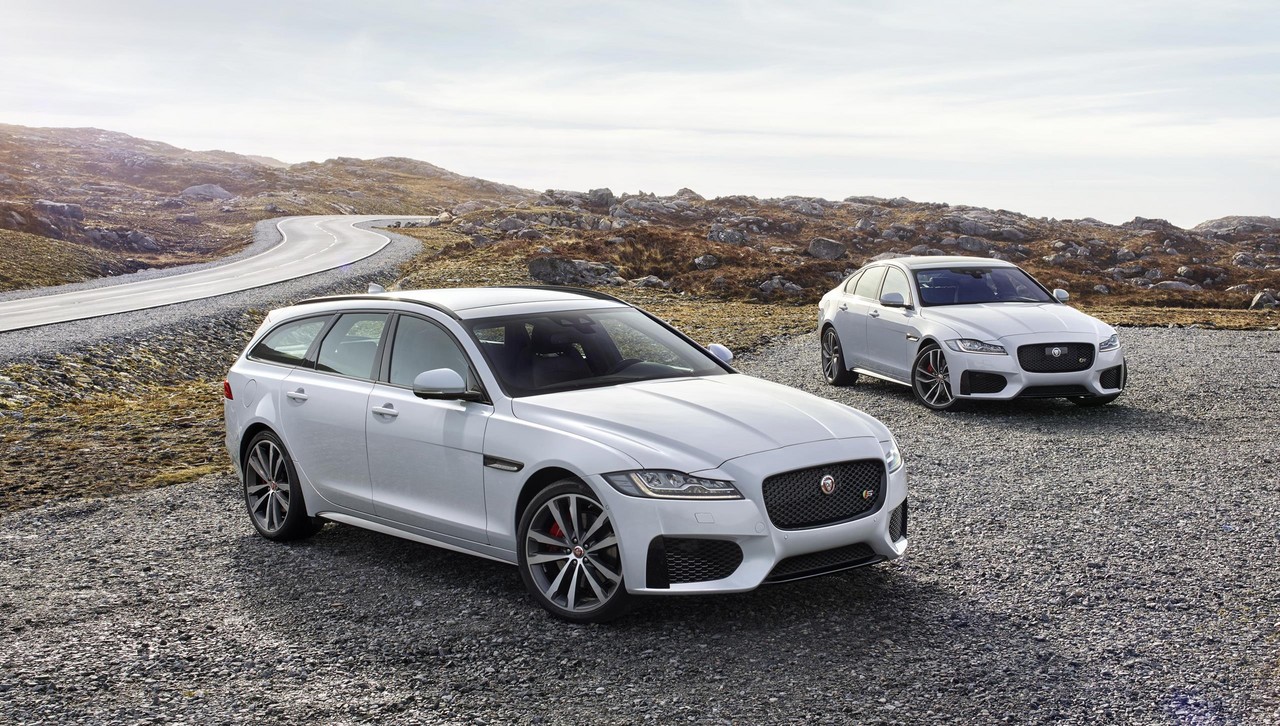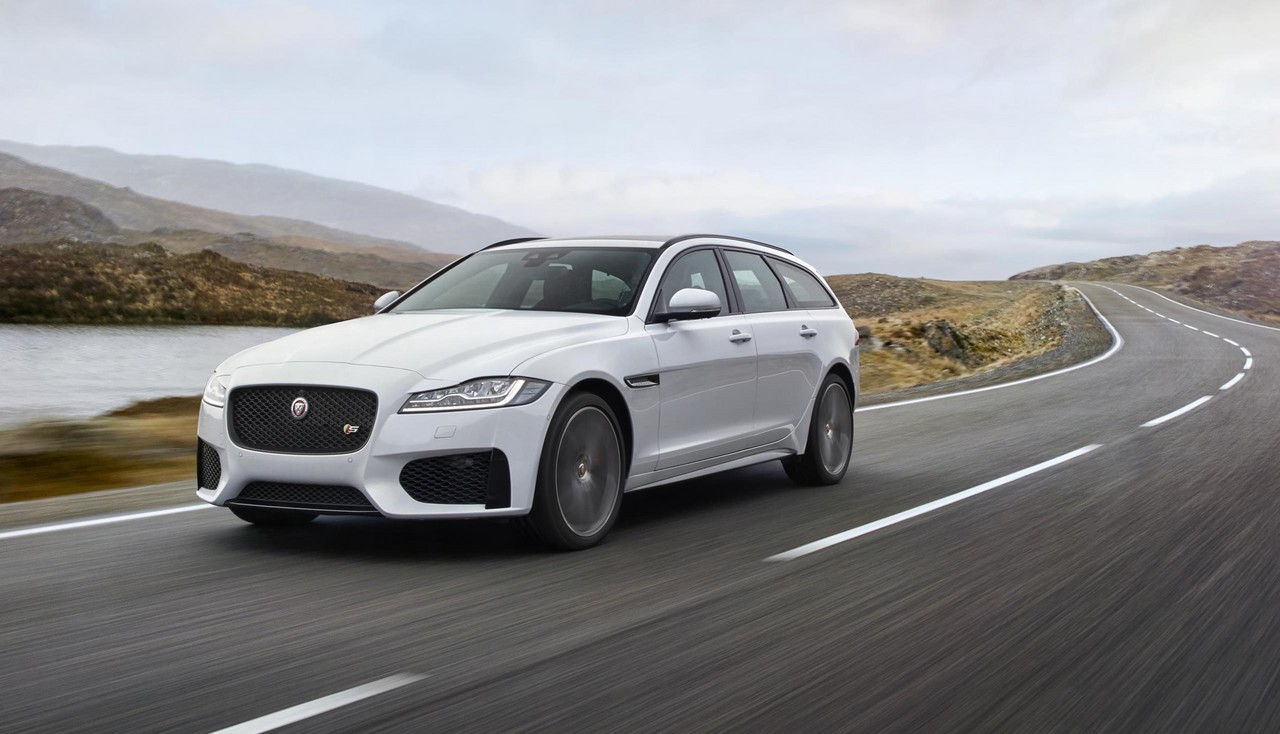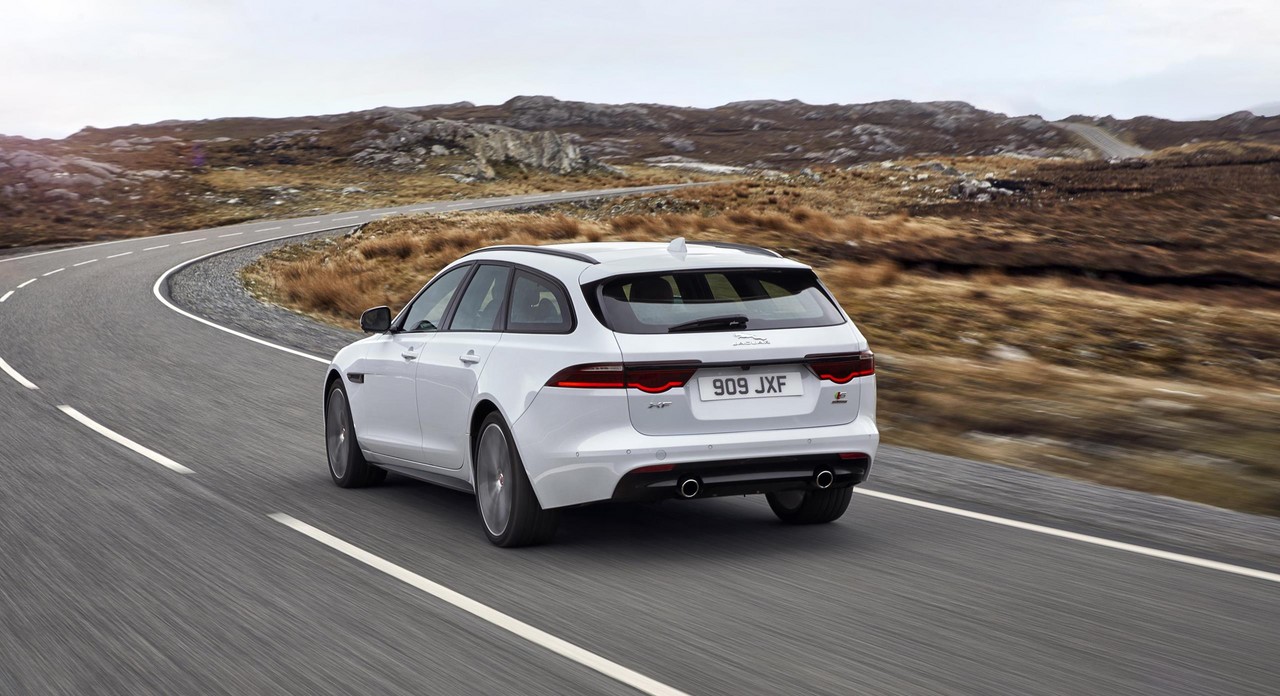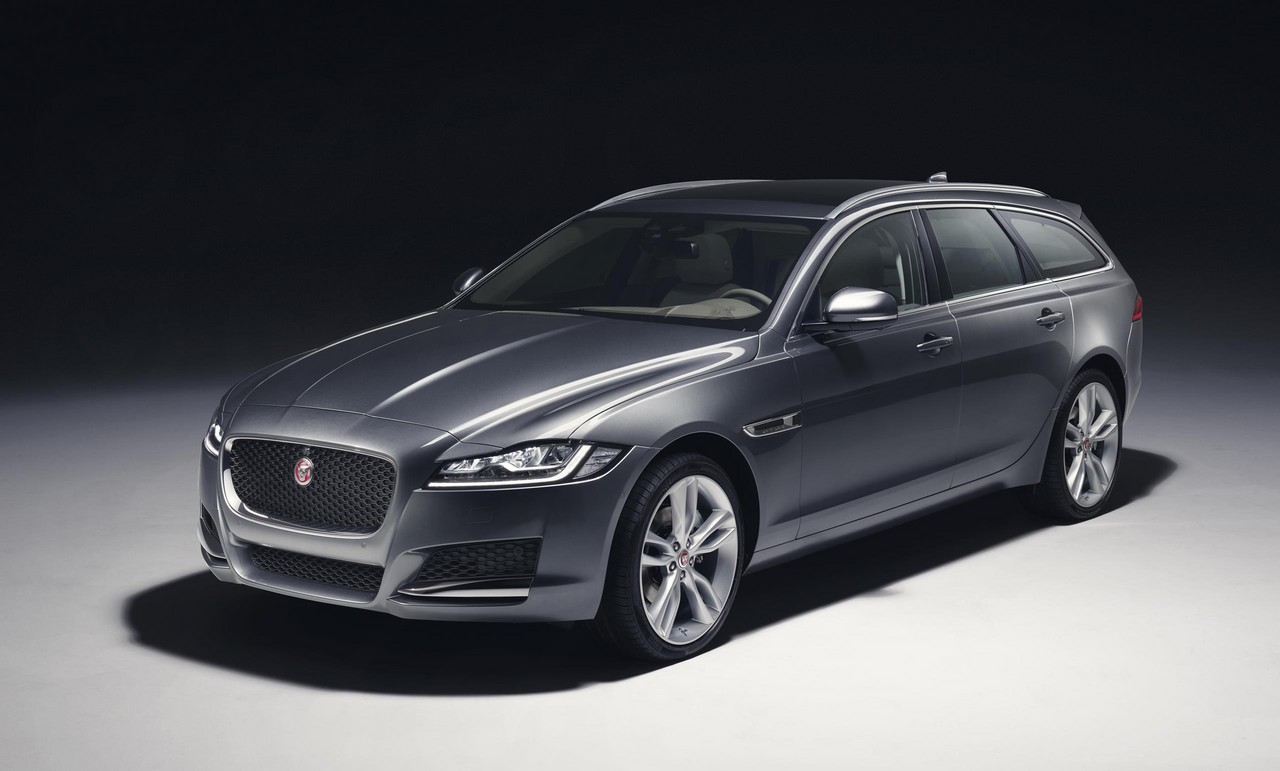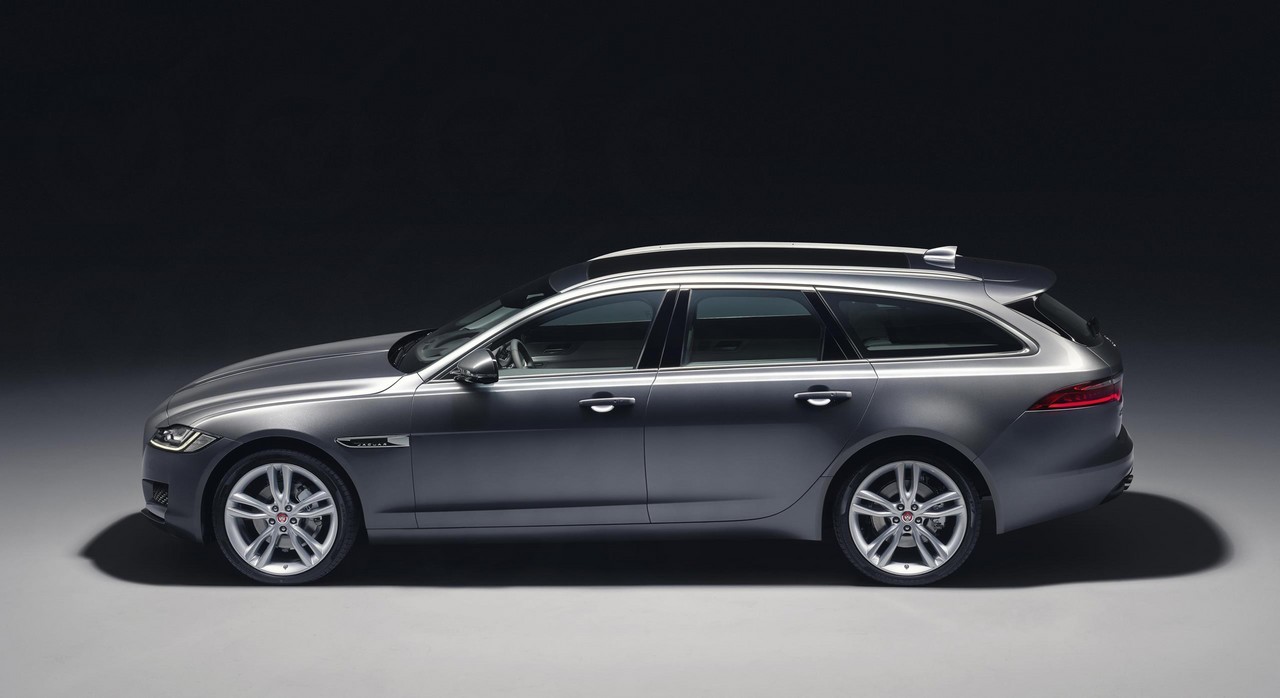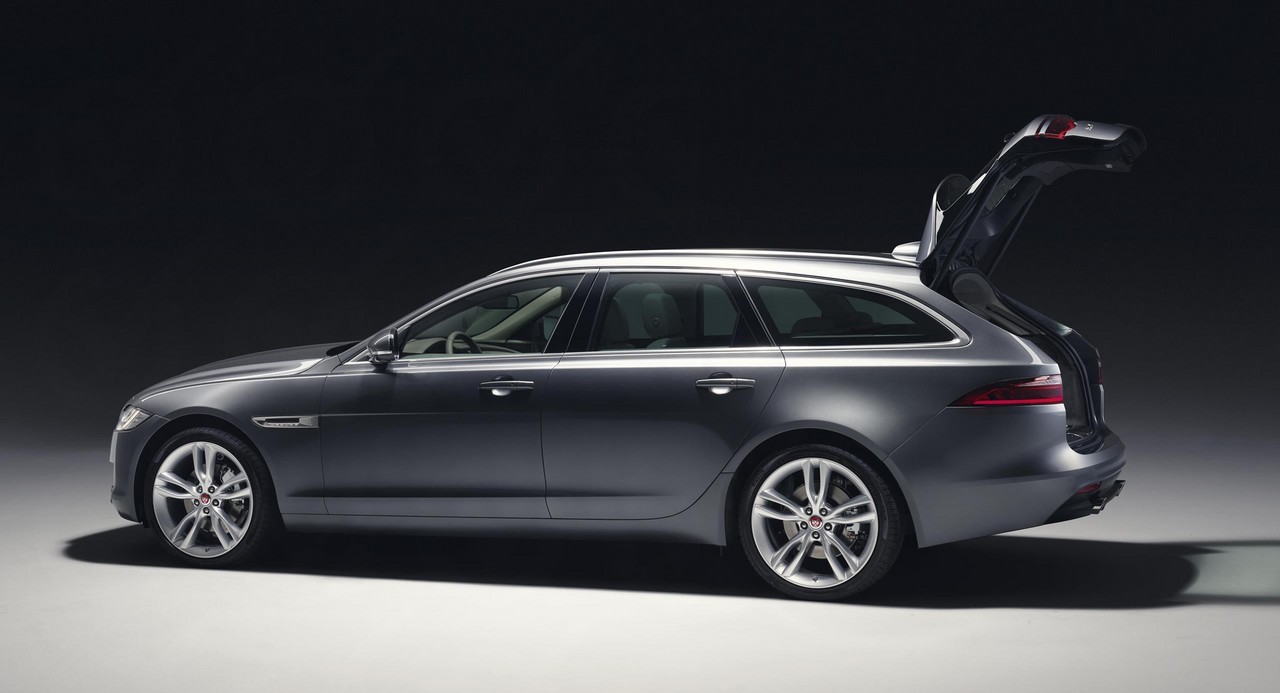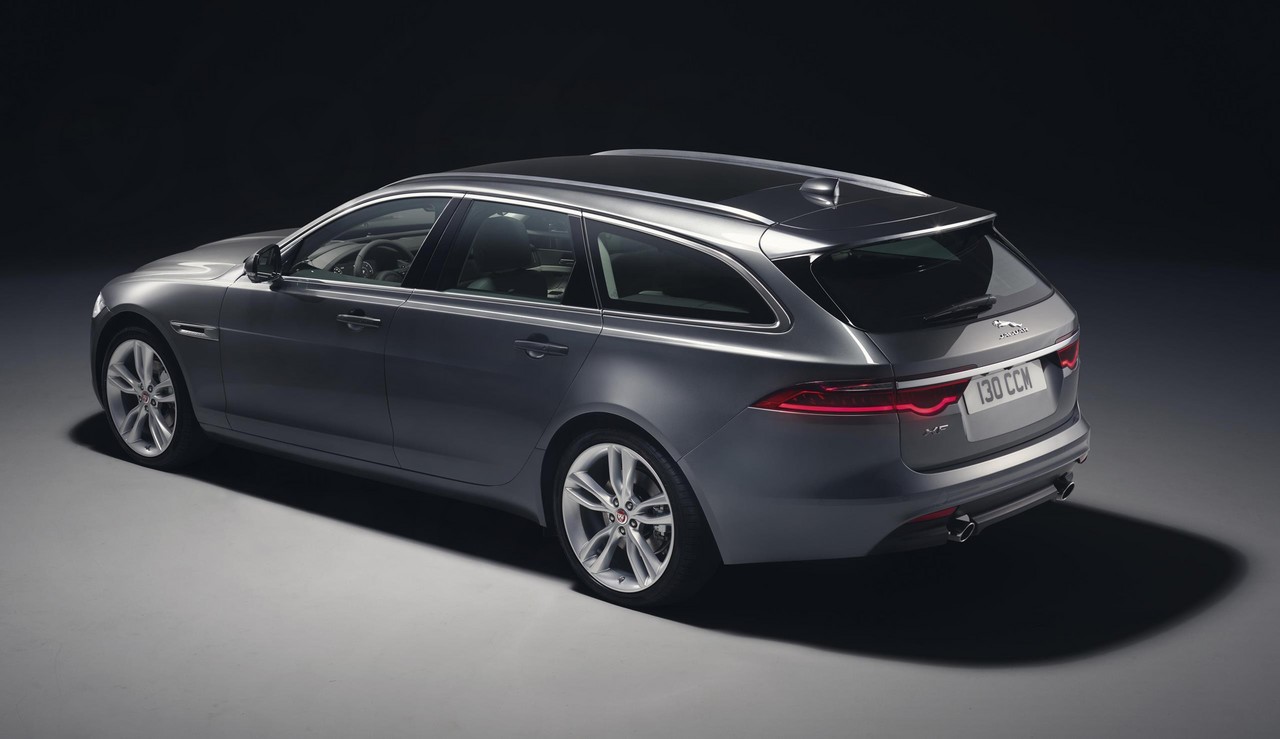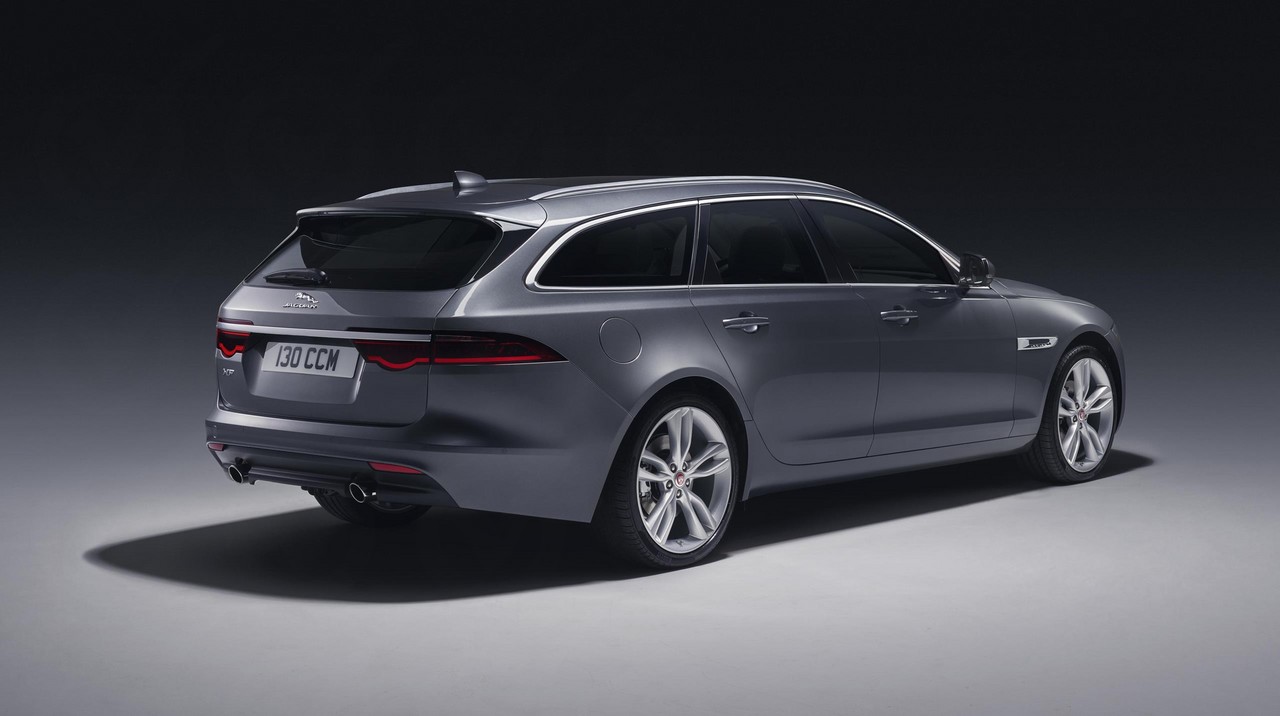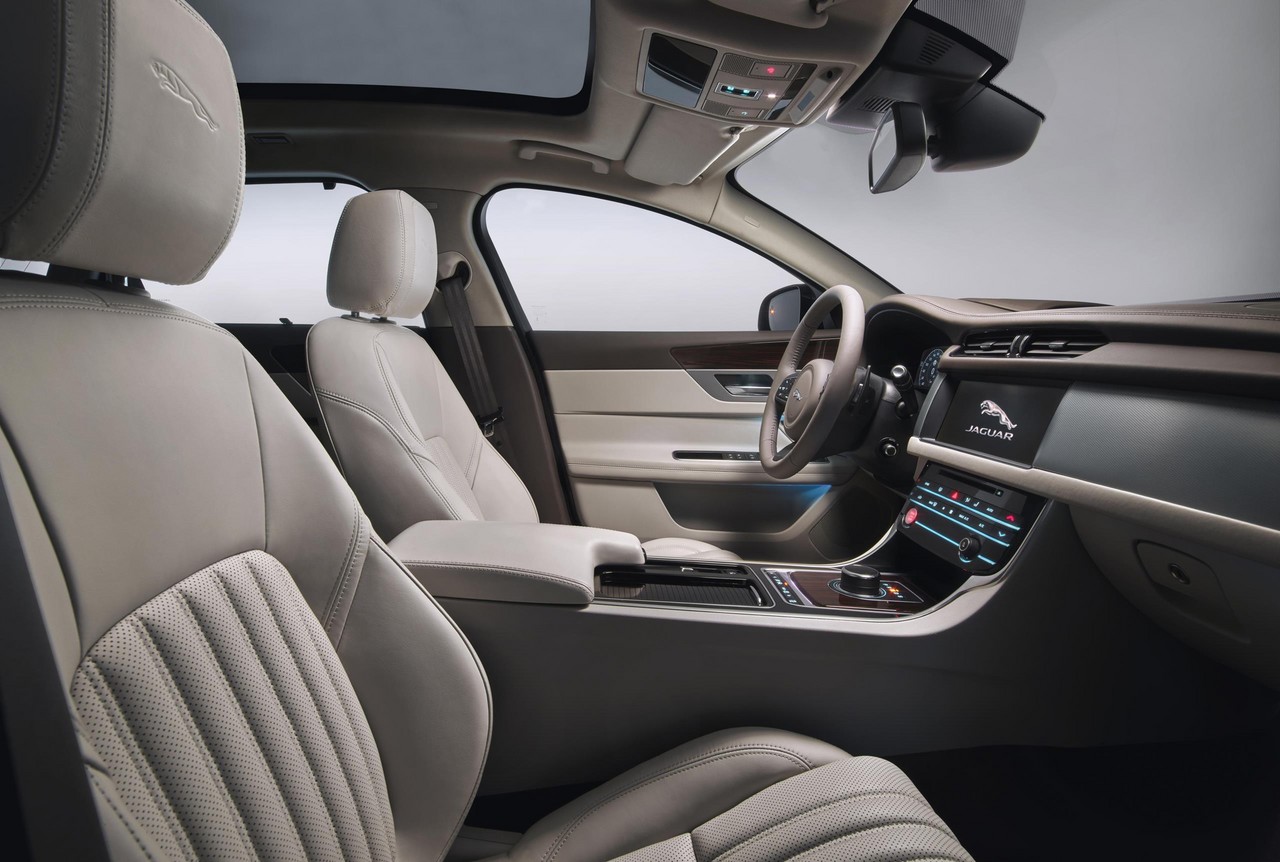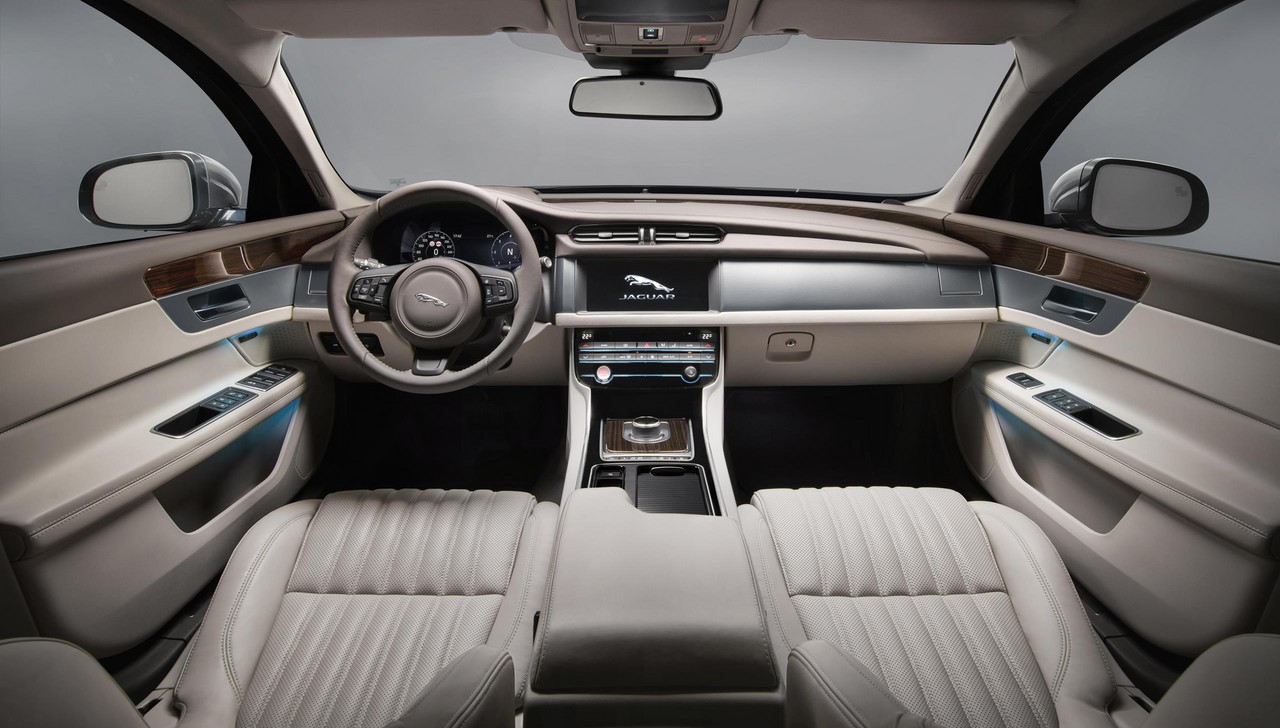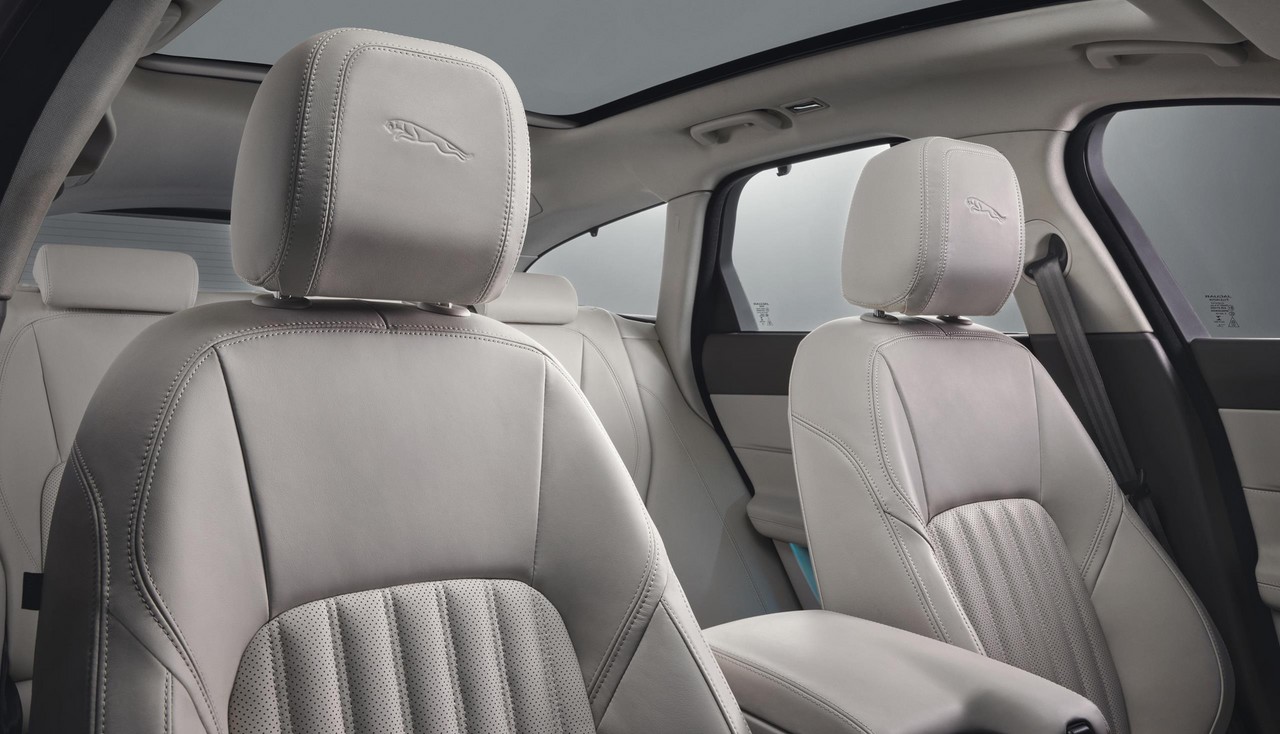
- Modern, fuel-efficient ‘Ingenium’ engines
- Impressive dynamics and a supple ride
- Direct and well-weighted steering
- Refined eight-speed ZF automatic transmissions
- Large boot
- Idle noise and vibration from ‘Ingenium’ diesel engine when cold
- Disruptive stop-start system
- Interior finishes fall short of BMW G30 5-Series and Audi C7 A6
Overview
Released in Australia in October 2017, the Jaguar X260 XF Sportbrake was an executive wagon. Manufactured at Jaguar Land Rover’s Castle Bromwich Plant in Birmingham, England, the rear-wheel drive Jaguar X260 XF Sportbrake was powered by 2.0-litre turbocharged petrol, 2.0-litre turbocharged diesel and 3.0-litre turbocharged diesel engines (see table below). Beyond the engine-based variants, the XF Sportbrake was offered in R-Sport and S editions; a limited-run ‘First Edition’ was also offered upon the XF Sportbrake’s release.
XF Sportbrake: Ingenium and 3.0-litre diesel engines
The 2.0-litre turbocharged petrol and diesel engines were members of Jaguar Land Rover’s ‘Ingenium’ engine family which featured deep-skirt aluminium cylinder blocks with thin-wall, press-fit cast iron liners. Beyond this,
- The 2.0-litre diesel engine had offset cylinder bearings, common-rail injection operating at up to 1800 bar, a single variable geometry turbocharger, double overhead camshafts with roller bearings, four valves per cylinder, a cam phaser for variable exhaust valve timing, a compression ratio of 15.5:1, exhaust gas recirculation (EGR), selective catalytic reduction (SCR) systems, split-cooling systems and twin counter-rotating balancer shafts; and,
- The 2.0-litre ‘Ingenium’ turbocharged petrol engine had an exhaust manifold which was integrated with the cylinder head casting, direct petrol injection operating at 200 bar, a single scroll turbocharger, double overhead camshafts, four valves per cylinder, variable intake and exhaust valve timing, continuously variable intake valve lift, a compression ratio of 10.0:1 and twin counter-rotating balancer shafts.
The 3.0-litre turbocharged diesel engine had a compacted graphite iron (CGI) cylinder block, an aluminium alloy cylinder head, common-rail injection operating at up to 2000 bar through eight-hole nozzles, sequential turbochargers, double overhead camshafts, four valves per cylinder and a compression ratio of 16.1:1. Of the turbochargers, the primary turbocharger had ceramic ball bearings which reduced friction and provided more rapid boosting. For emissions control, the 3.0-litre diesel engine had exhaust gas recirculation (EGR) and a selective catalytic reduction (SCR) system.
| Variant | Edition | Engine | Trans. | Peak power | Peak torque |
|---|---|---|---|---|---|
| 20d | R-Sport | 1999 cc AJ200D turbo diesel I4 | 8sp auto (ZF 8HP45) |
132 kW at 4000 rpm | 430 Nm at 1750-2500 rpm |
| 25t | R-Sport | 1997 cc AJ200P turbo petrol I4 | 8sp auto (ZF 8HP45) |
184 kW at 5500 rpm | 365 Nm at 1200-4500 rpm |
| 30d | S, S First Edition |
2993 cc 306DT twin turbo diesel V6 | 8sp auto (ZF 8HP70) |
221 kW at 4000 rpm | 700 Nm at 2000 rpm |
All Surface Progress Control (ASPC) and Adaptive Surface Response (ASR)
As standard, the Jaguar XF Sportbrake was fitted with Jaguar’s ‘All Surface Progress Control’ (ASPC) system. ASPC could maintain vehicle speed between 3.6 km/h and 30 km/h in low traction conditions by controlling the brakes and throttle to optimise traction – this enabled the driver to concentrate on steering the vehicle.
The XF Sportbake also had Jaguar’s ‘Adaptive Surface Response’ which worked in more variable conditions and allowed the driver to retain complete throttle control. When activated, ASR used algorithms to detect when the XF Sportbrake was driving on surfaces such as wet grass, snow, ice or gravel, and adapted to the changing grip levels.
Body and dimensions
Like the Jaguar X260 XF , the XF Sportbrake had an ‘aluminium-intensive’ architecture which made extensive use of high-strength, 5000- or 6000-series aluminium alloys and a magnesium cross-beam. The XF Sportbrake, however, had a new rear body structure and, according to Jaguar, ‘a near perfect 50:50 front-to-rear weight distribution’.
Compared to the Jaguar X260 XF sedan , XF Sportbrake was 1 mm longer (at 4955 mm) and 39 mm taller (1496 mm), though width (1880 mm) and wheelbase length (2960 mm) were unchanged. The Jaguar XF Sportbrake had a drag co-efficient of 0.29 Cd, and kerb weights from 1720 kg (for models with the 2.0-litre turbo petrol engine).
The Jaguar X260 XF Sportbrake had a luggage capacity of 565 litres with the rear seats in position, though this increased to 1700 litres when the split folding rear seats were lowered to provide a flat load floor and luggage was filled to the roofline. The rear seatbacks could be released using levers positioned inside the side panels of the boot or by using controls on the seatbacks; the luggage area also had four tie-down points and rails in the boot floor. The single-piece polymer tailgate– which included a bonded rear window – had a maximum loading width of 1061 mm and LED puddle lamps that illuminated the area behind the vehicle when the tailgate opened.
Suspension
The Jaguar X260 XF Sportbrake had double wishbone front suspension with forged aluminium alloy lower control arms, low-mass springs, bushes and a hollow anti-roll bar; the front suspension knuckle was also produced using Jaguar’s patented ‘Cobra Press’ process. The front dampers provided frequency-dependent damping whereby damping force was varied with both the velocity and frequency of the damper piston – this was achieved through the presence of an extra bypass valve in the damper piston. Specifically,
- At lower driving speeds, the valve was open to allow some fluid to flow through it instead of the main valve in the piston – this reduced damping forces for a more compliant ride; and,
- At higher driving speeds, the valve closed to force all of the fluid to pass through the piston, increasing damping force and providing a firmer ride.
At the rear, the XF Sportbrake had self-levelling rear integral-link suspension with air springs and hollow rear lower arms.
Adaptive Dynamics
The Jaguar X260 XF Sportbrake S and First Edition were equipped with Jaguar’s ‘Adaptive Dynamics’ electronically-controlled dampers which monitored wheel positions 500 times per second and body movements 100 times per second. In response, damping forces were adjusted to control vertical body movement, roll and pitch. Furthermore, Jaguar’s ‘Configurable Dynamics’ enabled the driver to select settings for the dampers, steering assistance, engine response and transmission behaviour.
Steering
The Jaguar X260 XF Sportbrake had rack-and-pinion steering with electric power assistance.
Safety equipment
Standard safety equipment for the Jaguar XF Sportbrake included dual front airbags, front side airbags, full-length curtain airbags, ABS, electronic brake force distribution, brake assist, electronic stability control, traction control and front seatbelts with pre-tensioners and load limiters.
As standard, the Jaguar XF Sportbrake was fitted with a stereo camera – mounted in front of the rear view mirror – which provided a 3D view of the road up to 100 metres ahead. At speeds up to 80 km/h, the autonomous emergency braking (AEB) system used this information to detect if a collision is imminent and, if so,
- Pre-charged the braking system;
- Warned the driver via a visual warning in the instrument cluster (and head-up display where fitted); and,
- If the driver failed to respond, would initiate emergency braking to avoid or mitigate a collision.
As standard, the Jaguar XF Sportbrake was fitted with a Lane Departure Warning (LDW) system which could monitor the vehicle’s position relative to lane markings and warn the driver if the vehicle was about to drift from its lane by providing a visual warning in the instrument panel and steering wheel vibrations.
To improve pedestrian protection in the event of a collision, the XF Sportbrake’s bonnet had a deployable hinge system (Jaguar’s ‘Pedestrian Contact Sensing’) which could create additional clearance between the bonnet and hard objects such as the engine, suspension towers and bulkhead.
Active Safety Pack
As an extra-cost option ($4360 at launch), the Jaguar XF Sportbrake could be specified with an ‘Active Safety Pack’ which included:
- Blind Spot Monitor (also known as Closing Vehicle Sensing): used 24 GHz radar sensors to alert the driver to vehicles quickly approaching from behind and, once they were within 70 metres, flashed an icon in the instrument panel to warn the driver. Once the vehicle entered the blind spot, the icon remains illuminated;
- Reverse Traffic Detection: used the same 24 GHz radar to detect approaching vehicles that may cross the reversing driver’s path and alert the driver;
- Adaptive Cruise Control (ACC) with Queue Assist: ACC used a long-range 77 GHz radar to maintain a safe distance from the vehicle ahead with automated braking and could bring the vehicle to rest. The Queue Assist function also enabled the XF Sportbrake to accelerate from rest when the driver touched the accelerator pedal and to track the vehicle ahead;
- Lane Keep Assist (also called Blind Spot Assist): enhanced the existing Blind Spot Monitor system by using the collision warning system in conjunction with the electric power steering system. If the driver was changing lanes and BSA detected that a vehicle was in the driver’s blind spot or approaching the blind spot, gentle steering force would be applied to keep the vehicle in its lane; and,
- Jaguar’s Driver Condition Monitoring system: assessed the driver’s steering inputs and interactions with other vehicle systems to detect fatigue. If detected, visual warnings in the instrument panel would alert the driver and prompt them to take a break.
Euro NCAP testing
In Euro NCAP testing , the related Jaguar X260 XF sedan received a five star safety rating which included a 92 per cent adult occupant protection rating and an 84 per cent child occupant protection rating. In the frontal offset test, protection of the driver’s head, thighs and feet were rated as good, though chest and lower left leg protection were rated as adequate (i.e. a slight risk of serious injury). While occupant protection was rated as good for all areas in the side impact test, a one point deduction was made because both doors on the impacted side of the vehicle became unlatched during the test. Maximum points were awarded, however, in the pole test.
Wheels, tyres and brakes
For Australian deliveries, the Jaguar XF Sportbrake had 8.0J x 19-inch alloy wheels with 245/40 R19 tyres fitted as standard. The XF Sportbrake R-Sport had 10-spoke alloy wheels, while the XF Sportbrake S had diamond turned five-spoke wheels which had a gloss dark grey finish. A space saver spare wheel was included as standard.
The Jaguar XF Sportbrake 20d and 25t had 325 mm by 30 mm ventilated front brake discs and 325 mm by 20 mm ventilated rear discs. The Jaguar XF Sportbrake 30d, however, had 350 mm by 32 mm ventilated front brake discs.
Features: Jaguar XF Sportbrake R-Sport
The ‘InControl Touch’ infotainment system for the Jaguar XF Sportbrake R-Sport featured an eight-inch touchscreen, SD card-based satellite navigation with 2D and 3D maps, USB and 3.5 mm auxiliary inputs, Bluetooth mobile phone connectivity and audio streaming, voice control and a 380 watt Meridian sound system with eleven speakers and subwoofer.
Beyond this, the Jaguar XF Sportbrake R-Sport had combination grained leather and ‘Technical Mesh’ seats, ten-way power adjustable front seats with four-way adjustable lumbar support, dual-zone climate control air conditioning, cruise control with speed limiter, xenon headlights with LED signature, dusk-sensing headlights, rain-sensing wipers, front and rear parking sensors, a rear view camera, 40:20:40 split and folding rear seats, a soft grain leather steering wheel, remote central locking with proximity key (i.e. keyless entry), power adjustable and heated door mirrors with folding function, power windows, a power adjustable steering column, an auto-dimming interior rear view mirror, driver memory settings (for the seat, steering column and door mirrors), push-button start, two 12 volt power sockets, carpet mats, illuminated vanity mirrors, a cargo cover, power-operated tailgate, tinted glass, gloss black roof rails, mood lighting, tyre pressure monitoring, a trip computer, an alarm and immobiliser.
The XF Sportbrake R-Sport was also fitted with Jaguar’s ‘Park Assist’ which provided automated steering for parallel parking, bay parking and when exiting from parking spaces.
Features: Jaguar XF Sportbrake S
Compared to the XF Sportbrake Prestige, the XF Sportbrake S added a digital radio tuner (DAB+), combination grained leather and suede cloth faced seats, adaptive LED headlights with automatic high beam assist, a head-up display (HUD), a surround camera system with 360 degree parking aid (i.e. virtual image from overhead perspective), an infra-red reflective windscreen, bright metal pedals and satin grey figured ebony veneers.
Visually, the XF Sportbrake S could be identified by its ‘S’ front and rear bumpers, satin chrome side vents and gloss black extended side sills.
Features: Jaguar XF Sportbrake S First Edition
The Jaguar XF Sportbrake S First Edition was distinguished by its ‘Navigation Pro’ system which included a 12.3-inch ‘Interactive Driver Display’ in place of conventional analogue instruments and its –
- A fixed panoramic roof with ‘Gesture Roof Blind’: the roof blind could open or close in response to hand motions;
- Powered gesture tailgate: could open or close in response to foot movement beneath the rear bumper; and,
- Jaguar’s ‘Activity Key’: a waterproof, shockproof wristband with an integrated transponder that enables the driver to lock the keyfob securely inside the vehicle. The driver can then lock or unlock the F-Pace by holding the Activity Key in close proximity to the ‘J’ of the Jaguar lettering on the tailgate.
Visual cues for the Jaguar XF Sportbrake S First Edition included its chrome side window surrounds and silver roof rails. Furthermore, the XF Sportbrake S First Edition was solely available in Farallon Pearl Black metallic paint finish.
2019 update
From early 2019, the Jaguar XF Sportbrake was equipped with a new ‘Smartphone Pack’ as standard which included Apple CarPlay and Android Auto smartphone integration.
2019 Jaguar XF Sportbrake Chequered Flag edition
In February 2019, ‘Chequered Flag’ editions of the Jaguar XF Sportbrake were released. Visually, the Jaguar XF Sportbrake Chequered Flag edition could be identified by its sport front bumper, 18-inch ‘Chalice’ alloy wheels finished in Gloss Black, Black Pack, side vent badges and body-coloured side sills. The Jaguar XF Sportbrake Chequered Flag editions were available in three paint colours: Yulong White, Santorini Black and Eiger Grey.
Inside, the Jaguar XF Sportbrake Chequered Flag editions featured R-Sport full leather seats, ‘Chequered Flag’ treadplates, a ‘Dark Hex’ aluminium instrument panel finisher and a choice of Jet/Jet or Jet/Red colour combinations with contrast stitching. Furthermore, standard features were extended to include Jaguar’s Navigation Pro with InControl Connect Pro for live traffic updates, a 12.3-inch Interactive Driver Display and keyless entry.
Specifications
